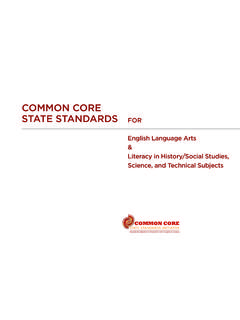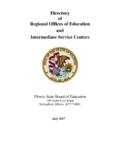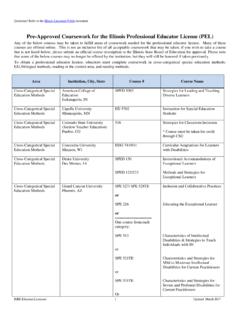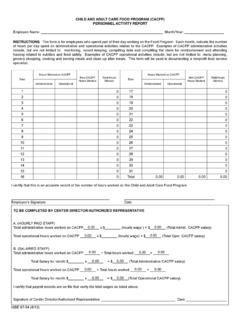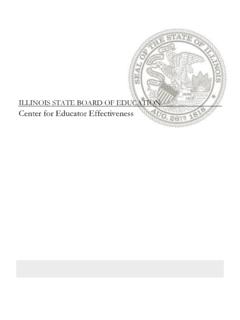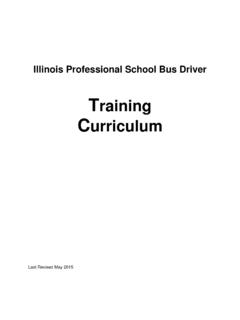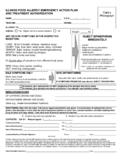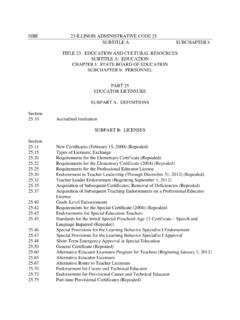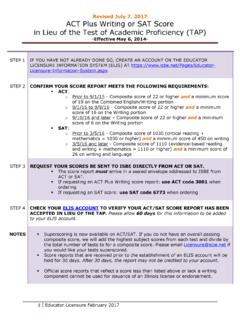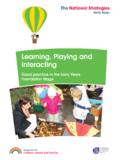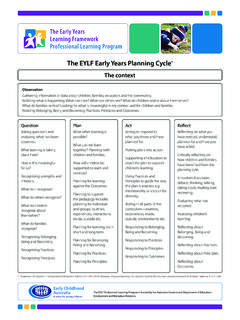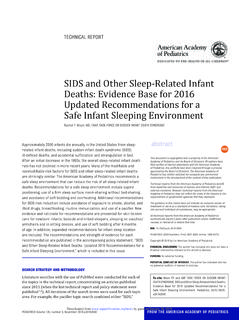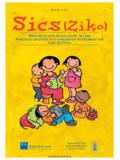Transcription of Illinois Early Learning and Development Standards: For ...
1 Revised septembeR 2013 For Preschool 3 yeaRs old to KindeRgaRten enRollment ageillinois Early Learning and Development standards | 1 | Contents Contents 2 | preface 4 | introduction 6 | Development of the Illinois Early Learning and Development standards 7 | purposes of the Illinois Early Learning and Development standards 8 | Uses of the Illinois Early Learning and Development standards 9 | terminology in the Illinois Early Learning and Development standards 16 | guiding principles 18 | How to navigate 21 | language arts 41 | mathematics 55 | science 63 | social studies 73 | physical Development and Health 83 | the arts 89 | english language learner Home language Development 93 | social/emotional Development 103 | References/Resources 111 | acknowledgments 121 | preschool benchmark indexillinois Early Learning and Development
2 standards , preschool Revised september 2013 | 2 |prefacethe Illinois Early Learning and Development standards (ields) provide reasonable expectations for children s growth, Development , and Learning in the preschool years. When used as part of the curriculum, the ields provide guidance to teachers in Early childhood programs to create and sustain developmentally appropriate experiences for young children that will strengthen their intellectual dispositions and support their continuing success as learners and students. the age-appropriate benchmarks in the ields enable educators to reflect upon and evaluate the experiences they provide for all preschool are cautions to consider when implementing the ields.
3 They are meant to be used to enhance planning for preschool children, to enrich play-based curricular practices, and to support the growth of each child to his or her fullest potential. they are not meant to push down curriculum and expectations from higher grades. the ields are research-based, so they identify expectations that are just right for preschool teachers in Early childhood programs implement the ields, they can be guided by dr. lilian Katz, internationally known Early childhood leader, expert, and professor emeritus at the University of Illinois at Urbana-Champaign.
4 Her reminder to expand our thinking beyond just the ields themselves and also consider standards of experiences is an important message for all. dr. Katz writes:As we think about standards , I suggest we ask ourselves: What are the standards of experience that we want all of our children to have? Below is a very preliminary list of some important standards of experiences that should be provided for all young children in all children should frequently have the following experiences: Being intellectually engaged, absorbed, challenged.
5 Having confidence in their own intellectual powers and their own questions. Being engaged in extended interactions ( , conversations, discussions, exchanges of views, arguments, planning). Being involved in sustained investigations of aspects of their own environment worthy of their interest, knowledge, understanding. Taking initiative in a range of activities and accepting responsibility for what is accomplished. Knowing the satisfaction that can come from overcoming obstacles and setbacks and solving problems.
6 Helping others to find out things and to understand them better.| 3 | preface Making suggestions to others and expressing appreciation of others efforts and accomplishments. Applying their developing basic literacy and numeracy skills in purposeful ways. Feelings of belonging to a group of their list is derived from general consideration of the kinds of experiences that all children should have much of the time in our educational settings. It is based on philosophical commitments as well as the best available empirical evidence about young children s Learning and the focus of program evaluation and assessment is on outcomes such as those indicated by test scores, then evaluators and assessors would very likely emphasize the drill and practice of phonemics, or rhyming, or various kinds of counting, or introductory arithmetic.
7 While in and of themselves such experiences are not necessarily harmful to young children, they overlook the kinds of experiences that are most likely to strengthen and support young children s intellectual dispositions and their innate thirst for better, fuller, and deeper understanding of their own experiences. A curriculum or teaching method focused on academic goals emphasizes the acquisition of bits of knowledge and overlooks the centrality of understanding as an educational goal. After all, literacy and numeracy skills are not ends in themselves but basic tools that can and should be applied in the quest for understanding.
8 In other words, children should be helped to acquire academic skills in the service of their intellectual dispositions and not at their Lilian Katz, professor emeritus University of Illinois at Urbana-Champaign November 2012illinois Early Learning and Development standards , preschool Revised september 2013 | 4 |introductiondear Colleagues,i am pleased to introduce to you the revised Illinois Early Learning and Development standards 2013 (ields), formerly known as the Illinois Early Learning standards . the purpose of the updated ields is to assist the Illinois Early childhood community in providing high-quality programs and services for children age 3 years to kindergarten enrollment (as defined in section 10-20-2012 of the school Code).
9 The standards are organized to parallel content in the Illinois state goals for Learning (see 23 Illinois administrative Code 1. appendix d found on the Illinois state board of education Web site, ). the revised standards also demonstrate alignment to the Illinois Kindergarten standards and the Common Core state standards for Kindergarten. the Kindergarten Common Core language standards are found at and the Kindergarten Common Core mathematics are found at original Illinois Early Learning standards document, published in 2002, was developed by the Illinois state board of education (isbe) with assistance from the Chicago public schools, deKalb Community Unit school district, indian prairie school district, and Rockford public school district.
10 The Development of the revised ields includes additional assistance from the erikson institute in Chicago as well as eight content-area experts who are nationally and internationally known leaders in the field of Early childhood Illinois Early Learning and Development standards are broad statements that provide teachers with reasonable expectations for children s Development in the preschool years. based on the broad Illinois state goals and standards (see Illinois administrative Code, section 235, appendix a), this resource includes preschool benchmarks and performance descriptors for most Learning standards .
